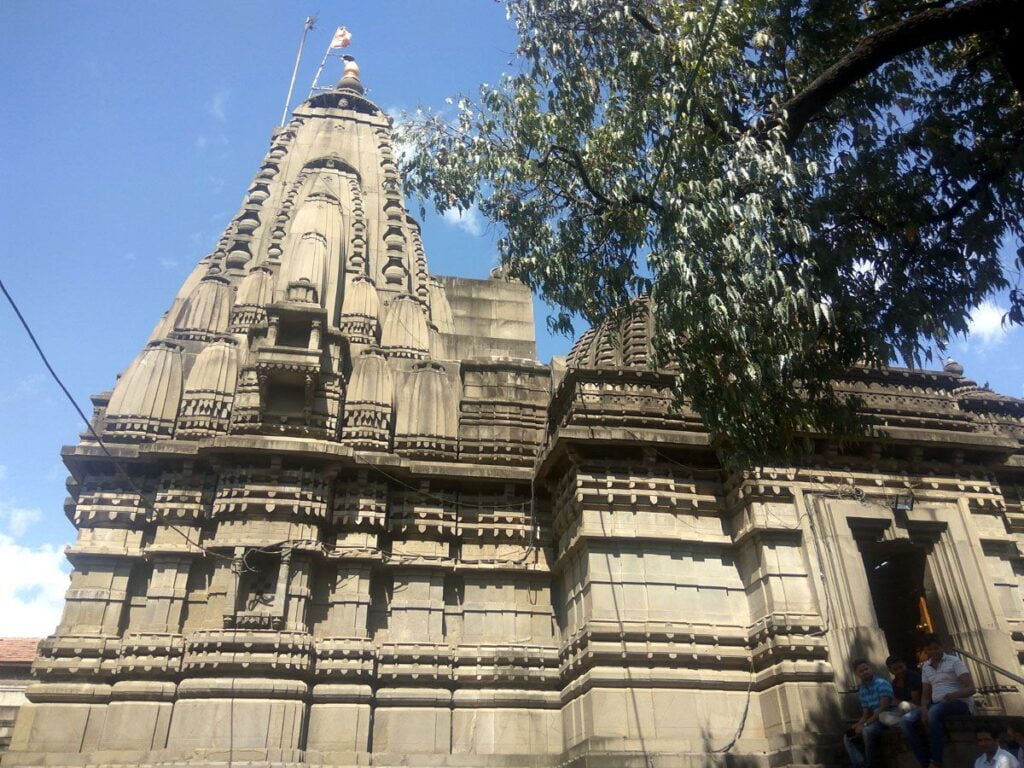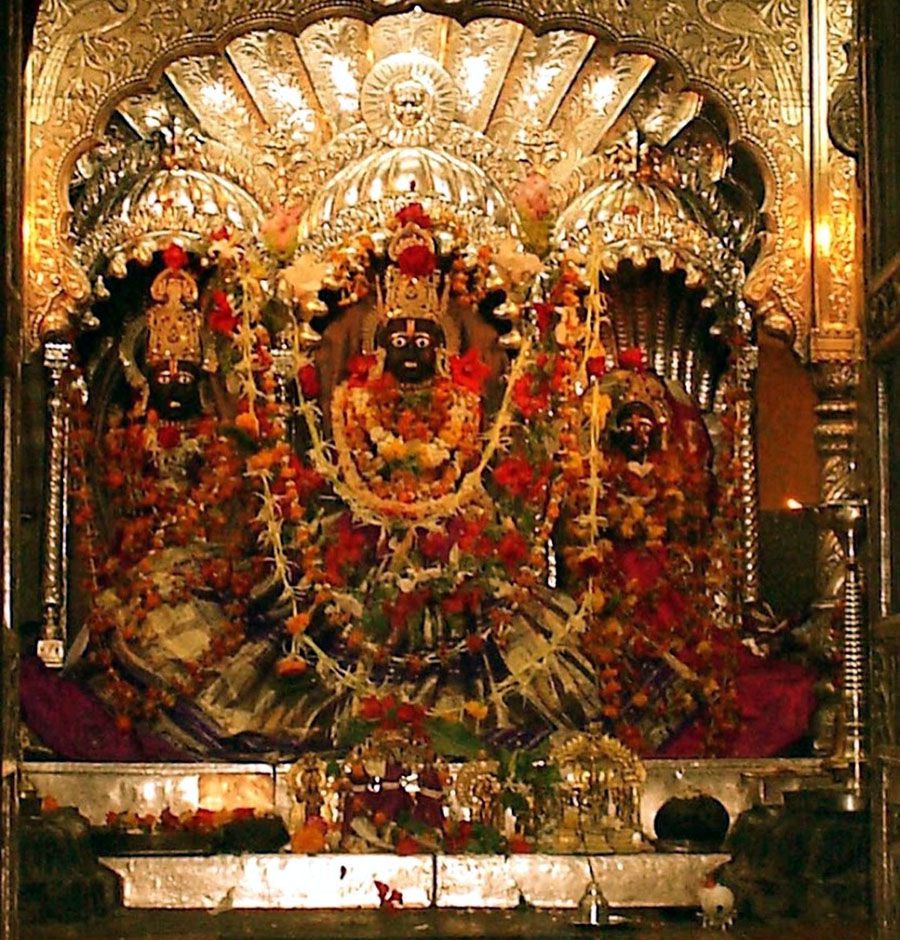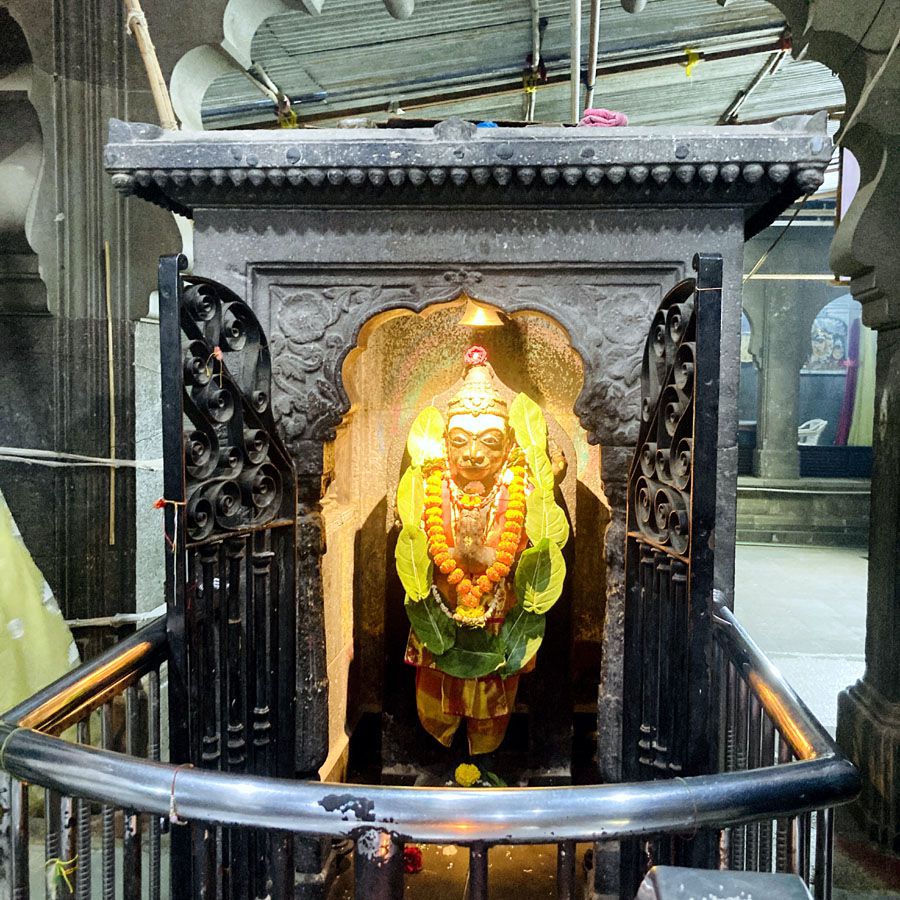Kalaram Temple Nashik
The Kalaram Temple is a Hindu temple in the city of Nashik, Maharashtra, dedicated to the revered deity Lord Rama. Located in the holy Panchavati area, it draws thousands of devotees daily, making it one of the most important pilgrimage sites in the region.

Contents
Kalaram Temple History:
Early Traces:
- While the current structure dates back to the late 18th century, the earliest whispers of the site point to a much older lineage.
- Some believe an ancient temple, possibly belonging to the Rashtrakuta period (7th-11th centuries), once stood on this ground.
- Legend tells of a pre-existing idol at the site, possibly dedicated to an unknown deity, that faced desecration during early Turkish invasions. Temple priests, in a desperate act of protection, are said to have hidden the idol in the Godavari’s depths.
The Rebirth of Kalaram:
- Enter Sardar Rangarao Odhekar, a pious man who, in 1788, had a prophetic dream.
- The dream, vivid and divine, revealed the black-hued idol of Lord Rama resting within the Godavari. Undeterred by doubt, Odhekar embarked on a mission to retrieve the lost deity.
- Miraculously, his efforts bore fruit, and the majestic black Rama idol was recovered from the riverbed. This divine discovery set the stage for the temple’s magnificent reconstruction.
A Tapestry of Faith and Change:
- With unwavering dedication, Odhekar laid the foundation for the present-day Kalaram Temple. Completed around 1792, it became a cherished sanctuary for devotees.
- The black Rama idol, the temple’s namesake, is carved from black stone and resides in the sanctum sanctorum, alongside statues of Sita and Lakshmana.
- Beyond its spiritual significance, Kalaram Temple also holds a pivotal place in India’s social history. On March 2nd, 1930, Dr. B. R. Ambedkar led a historic protest outside the temple gates, demanding equal access for Dalits to the holy site. This marked a crucial moment in the fight for social justice in India.
Standing Tall Today:
- Today, Kalaram Temple remains a bustling hub of devotion, drawing thousands of pilgrims daily. Its exquisite architecture, serene atmosphere, and rich history continue to enchant visitors from all walks of life.
- From ancient mysteries to modern struggles for equality, the Kalaram Temple stands as a testament to the enduring power of faith, resilience, and hope.
Read More>> Matsya Narayana Temple Chennai

Legend of Kalaram Temple:
Legend of the Black Rama:
One popular legend narrates the story of a pious nobleman, Sardar Rangarao Odhekar, who dreamt of a black Rama statue resting in the depths of the Godavari River. Guided by his dream, he ventured into the river and miraculously retrieved the idol, along with statues of Sita and Lakshmana. In 1782, he built the Kalaram Temple to enshrine these divine figures.
Another legend attributes the black color to Rama’s grief during his 14-year exile. Separated from Sita and Lakshmana, his anguish is said to have imbued the idol with its somber hue.
Beyond the Blackness:
The Kalaram Temple transcends its unique idol, holding significance for various reasons:
- Pilgrimage Site: Situated in Panchavati, the legendary forest where Rama is believed to have resided during his exile, the temple draws thousands of devotees seeking blessings and spiritual solace.
- Architectural Gem: The temple boasts intricate carvings, 14 steps symbolizing Rama’s exile, and 84 pillars representing the cycle of rebirth.
- Symbol of Equality: In 1930, Dr. B.R. Ambedkar led a peaceful satyagraha at the temple, demanding entry for Dalits who were historically denied access. This marked a crucial moment in India’s fight against untouchability and caste discrimination.
Read More>> Prashar Rishi Temple, Himachal Pradesh

Myths of Kalaram Temple:
The Divine Dream and the River:
- The most famous myth concerns the temple’s namesake idol. According to legend, in the late 18th century, a local chieftain named Sardar Rangarao Odhekar had a vivid dream. In the dream, he saw a black statue of Lord Rama submerged in the Godavari River, flowing near the Panchavati area.
- Upon waking, Odhekar, a devout follower of Rama, felt compelled to follow the dream’s guidance. He organized a team and launched a search mission in the river. Miraculously, they discovered the very statue he had seen in his dream, a beautiful black stone idol of Lord Rama.
- Sardar Odhekar, interpreting this as a divine blessing, took the idol and built a temple around it. This temple came to be known as the Kalaram Temple, with “Kala” meaning “black” in Hindi.
The Temple’s Ancient Origins:
- While the current temple structure dates back to the late 18th century, some legends claim the site itself has a much older history. Some believe an ancient temple dedicated to an unknown deity existed at the same location during the Rashtrakuta period (7th to 11th centuries).
- Another legend suggests the black Rama idol itself might be much older than the temple, possibly even dating back to the Ramayana era. However, there’s no historical or archaeological evidence to support this claim.
A Symbol of Equality and Protest:
- The Kalaram Temple holds significance beyond its mythological connections. In 1930, it became a pivotal site in the fight for social equality in India. Dr. B.R. Ambedkar, a champion of Dalit rights, led a peaceful protest demanding access to the temple for all, regardless of caste.
- While the protest didn’t immediately achieve its goal, it marked a turning point in the struggle for social justice. The Kalaram Temple, with its association with both ancient myths and modern social movements, continues to be a powerful symbol of inclusivity and hope.
Read More>> Mahabaleshwar Temple Maharashtra: 1200 yrs Sacred Atmalinga

Significance of Kalaram Temple:
Religious Significance:
- Association with Ramayana: The temple stands on the banks of the Godavari River, believed to be the same place where Lord Rama, along with Sita and Lakshmana, spent a part of their 14-year exile during the events of the epic Ramayana.
- Unique Idol: The black statue of Rama is a distinguishing feature, attracting devotees seeking blessings and spiritual connection.
- Symbolic Architecture: The temple’s design elements hold symbolic meanings. The 14 steps leading to the main shrine represent Rama’s 14 years of exile, while the 84 pillars signify the cycle of rebirth in Hinduism.
Historical Significance:
- Satyagraha for Temple Entry: In 1930, the Kalaram Temple became a pivotal ground for the Dalit movement led by Dr. B.R. Ambedkar. He organized a satyagraha demanding temple entry rights for Dalits, challenging the discriminatory caste practices prevalent at the time. While the protest faced resistance, it sparked a nationwide movement for social justice and equality.
- Cultural Heritage: The temple stands as a testament to India’s rich cultural heritage and Ramayana’s enduring influence. It continues to be a popular pilgrimage destination for Hindus from all over the country.
Read More>> Saptashrungi Bhadrakali Temple Nasik
Kalaram Temple Timing and Rituals:
Timings:
- Darshan (Viewing the deity):
- Morning: 5:00 AM – 12:00 PM
- Evening: 4:00 PM – 8:00 PM
- Aarti (Ritual worship):
- Morning: 6:00 AM, 9:00 AM, 11:00 AM
- Evening: 5:00 PM, 7:00 PM
Rituals:
- Puja (Worship): Devotees can offer prayers and floral offerings to the deity Rama during darshan times. Priests also perform various pujas throughout the day.
- Abhishek (Holy bath): The idol of Rama is bathed with milk, panchamrit (five nectars), and other sacred substances during specific pujas.
- Bhog (Offering food): The deity is offered various food items like fruits, sweets, and savories several times a day. This prasad (blessed food) is then distributed to devotees.
- Mantras and Bhajans (Chants and hymns): Priests recite devotional chants and hymns throughout the day, creating a spiritual atmosphere.
- Aarti: This is a ritualistic offering of light to the deity using lamps. It is performed several times a day and is considered a very auspicious act.
Read More>> Titwala Ganesh Mandir: Where Devotion Meets Serenity

Interesting facts about Kalaram Temple:
Historical Intrigue:
- Ancient Origins: While the current structure dates back to 1792, the original temple at the site is believed to be much older, possibly from the Rashtrakuta period (7th-11th centuries).
- Riverine Rescue: Legend has it that during early Turkish invasions, the temple priests threw the original deity’s idol into the Godavari River to protect it. The current black statue of Rama is said to have been recovered from the river later.
- Unique Connection to Ramayana: The temple sits in Panchavati, a region closely associated with Lord Rama’s exile in the epic Ramayana.
Distinctive Features:
- Black Beauty: The temple’s name, “Kalaram,” translates to “black Rama.” The unique black stone statue of Lord Rama, along with black idols of Sita and Lakshmana, is the temple’s most striking feature.
- Architectural Charm: The temple boasts a spacious courtyard, a beautifully carved sabhamandap (assembly hall), and a seventeen-feet high enclosing wall. Its design blends traditional elements with modern touches.
- Festival Fervor: Ramnavami, celebrating Lord Rama’s birthday, is the temple’s grandest festival, drawing thousands of devotees with vibrant processions and devotional fervor.
Beyond the Ordinary:
- Dream Discovery: According to local lore, the current temple’s construction was inspired by a dream of Sardar Rangarao Odhekar, who saw the black Rama statue in the Godavari River.
- Spiritual Significance: The temple is not just a historical marvel but also a revered place of worship, attracting devotees seeking blessings and spiritual solace.
- Modern Influence: In recent years, the temple has gained national recognition with visits from prominent figures like Prime Minister Narendra Modi, further highlighting its cultural significance.
Read More>> Shirdi Sai Baba Temple Maharashtra
Places to visit near Kalaram Temple:
- Sita Gufa (Sita Cave): Located in Panchavati, Sita Gufa is believed to be the spot where Sita stayed during her exile. It is a small cave and is associated with the Ramayana.
- Panchavati: Panchavati is a sacred area in Nashik and is associated with the stay of Lord Rama, Sita, and Lakshmana during their exile. Apart from the Kalaram Temple, you can explore the Tapovan area and other temples in Panchavati.
- Ramkund: Ramkund is a sacred tank in Panchavati where devotees take a holy dip. It is believed that Lord Rama performed his ablutions in this tank.
- Sundarnarayan Temple: This temple is dedicated to Lord Vishnu and is situated in the Panchavati area. It is known for its beautiful architecture and carvings.
- Trimbakeshwar Shiva Temple: Located around 28 kilometers from Nashik, Trimbakeshwar is one of the twelve Jyotirlinga shrines dedicated to Lord Shiva. It is a significant pilgrimage site.
- Anjaneri Hills: Anjaneri is believed to be the birthplace of Lord Hanuman. The Anjaneri Hills offer a trekking opportunity and panoramic views of the surrounding landscapes.
- Nashik Caves: The Nashik Caves, also known as Pandavleni Caves, are ancient rock-cut caves dating back to the 1st century BC. They are located on the Trivashmi Hills and are known for their Buddhist architecture.
- Coin Museum: The Coin Museum in Nashik is an interesting place to visit, showcasing a vast collection of coins from different historical periods.
- Gangapur Dam: About 10 kilometers from Nashik, Gangapur Dam is a serene spot for picnics and offers a peaceful environment. Boating facilities are also available here.
- Someshwar Temple: Located near the Godavari River, the Someshwar Temple is dedicated to Lord Shiva and is known for its tranquil surroundings.
FAQ:
Q: Where is the Kalaram Temple located?
The Kalaram Temple is located in the Panchvati area of Nashik, Maharashtra, India. It’s about 3 km from the central bus stand and easily accessible by city buses or auto rickshaws.
Q: What is the significance of the temple?
The Kalaram Temple is dedicated to Lord Rama, a revered Hindu deity and the protagonist of the epic Ramayana. The unique feature of the temple is the black stone statue of Lord Rama, which gives it the name “Kalaram,” meaning “Black Rama.”
The temple holds significant religious and cultural value for Hindus. Many believe it stands on the spot where Lord Rama resided during his exile.
Q: When was the temple built?
The current temple structure was built in 1792 by Sardar Rangarao Odhekar on the site of an older wooden temple. However, the original temple dedicated to an unknown deity is believed to date back to the Rashtrakuta period (7th to 11th centuries).
Q: What are the main features of the temple?
The Kalaram Temple has a traditional architectural style with a 17-foot-high wall encircling a well-maintained courtyard. The sanctum sanctorum houses the black stone statues of Lord Rama, Sita, and Lakshmana.
Inside the temple, you can find intricate carvings, beautiful artwork, and a peaceful atmosphere.
Q: What are the festivals celebrated at the temple?
The main festival celebrated at the Kalaram Temple is Ramnavami, which marks the birth anniversary of Lord Rama. It falls in the Chaitra month (March-April) and is observed with great fervor by devotees.
Other important festivals include Janmashtami (Krishna’s birthday), Hanuman Jayanti (Hanuman’s birthday), and Maha Shivratri (Lord Shiva’s night).
Q: What are the timings for visiting the temple?
The Kalaram Temple is open to the public from 6:00 AM to 9:00 PM daily.
Q: Are there any special rules or dress codes for visiting the temple?
Yes, visitors are expected to dress modestly and respectfully when entering the temple. Men should avoid wearing shorts and women should avoid wearing revealing clothing. Additionally, footwear is not allowed inside the temple premises.
Q: Are there any facilities available for tourists near the temple?
Several hotels, restaurants, and shops are located near the Kalaram Temple, catering to the needs of tourists and pilgrims.
How to reach Kalaram Temple Nashik:
By Air:
- The nearest airport is Gandhinagar Airport in Nashik. From the airport, you can hire a taxi or use other transportation options to reach the Kalaram Temple. The airport is approximately 15 kilometers away from the temple.
By Train:
- Nashik has its railway station, Nashik Road Railway Station, which is well-connected to major cities. From the railway station, you can hire a taxi or use local transportation to reach the Kalaram Temple. The railway station is approximately 10 kilometers away.
By Bus:
- Nashik is well-connected by road, and there are regular bus services from major cities in Maharashtra. The Kalaram Temple is easily accessible by bus, and you can find local transport options within Nashik to reach the Panchavati area where the temple is situated.
By Car:
- If you are driving, you can use navigation apps or maps to find the best route to Kalaram Temple. Nashik is well-connected by road, and you can follow the directions to Panchavati, where the temple is located. Parking facilities may be available near the temple.
